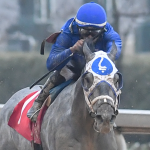
Preakness Quick Sheet: Get to Know the 2021 Preakness Horses

They say Saratoga is “The Graveyard of Champions,” so if you’re playing there later this summer you’re probably looking for a way to pick some good longshots. If you’re a greenhorn at the racetrack, and you’re looking for an easy way to pick some live ones, then perhaps you should consider the turn-back angle.
The turn-back angle is a tried-and-true handicapping angle. Some folks swear it’s the best play day-to-day at the track, and has been for many years. Its value to the handicapper isn’t in identifying probable winners, but in evaluating longshots to identify ones that are especially live. The difference is important.
Remember that when betting longshots, you’re almost always going to be picking horses that aren’t the fastest, the best bred, the highest class, or the best-looking horses in the field. Those horses, naturally, are the favorites. The fastest and classiest horses probably are going to win, so everyone is betting them, which means the payoff is going to be short money.
If you want to hit a longshot — to bet a little and win a lot — then you’ll need to find a horse that has been overlooked. And the turn-back angle is one way to find just such an overlooked horse with a chance to upset the field and win the race.

The basic gist of the angle is to find a horse who lost its last race at a longer distance and is “turning back” to a shorter distance in this start. That’s not all there is to it, but that’s the general idea.
What you’re trying to find is a horse that has the speed and stamina for this distance and surface, but was running too far last time out and couldn’t deliver at the longer distance. You want to look at the past-performance lines for the horse and see that it was on the lead or close to it throughout the race, at least up to the point of today’s distance, before getting passed by closers in the stretch.
For example, if your horse was running in a mile race last time out, and today is entered at six furlongs, you’ll want to look at how your horse was doing at the ¾-mile split in the last race.
Sometimes, horses simply don’t have the stamina for that last quarter-mile or so and get passed by horses who know how to rate and close. Sometimes horses just get tired. Either way, the right scenario for the turn-back angle to work is for that horse to have both built stamina and strength through the losing effort and be ready to run at what hopefully is the ideal distance for their style.
This angle is obviously no sure thing — nothing at the racetrack is. And it’s even more of a stretch play if you only have one race at the longer distance with which to compare. Ideally, you’d have a lot of times to look at and confirm your sense that the shorter distance is going to offer the horse an opportunity to improve.

One thing you can also check out is par times. If you pay for or have access to the par times for the type of race at the track you’re betting, you can compare the par time for the race with the comparable split in the longer races for your runner. Likewise, you can look at trainer stats in the Daily Racing Form to see how your trainer typically does with this type of “route-to-sprint” adjustment. These should help you confirm your sense that your longshot has a chance to win that might be significantly better than the long odds you’re getting presume.
The turn-back is an elegant handicapping angle because it makes logical sense. Run the horse at the distance they can keep up their fastest pace. But beware, there are many reasons a horse may get passed in the stretch. It isn’t always because the horse can only keep up their speed for six furlongs. It could be that they were chasing a pace-setting horse who was running too fast and they tired too quickly. The same thing could happen in a sprint. You want to trust and respect your trainer and your jockey. Most importantly, when looking at this angle, as with any longshot angle, you want to get a good price. Let the odds make up your mind for you.
This angle is a way to find hidden talent and promise that might not leap off the page to the general public. But remember that the general public is right more than a third of the time.
If you try the turn-back angle and it doesn’t work for you, come back here and look for an easier handicapping angle to try next time. After all, horseplayers can “turn back,” too.
Note: This story was originally published in July 2019 and has been updated.